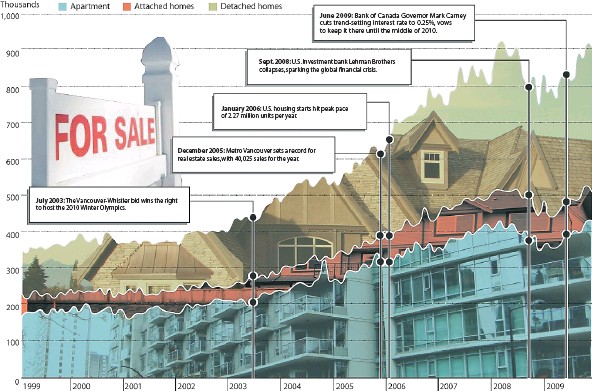Property assessments for all B.C. homeowners are arriving this week
Don Cayo
Sun
The 2009 property assessments– the values on which British Columbians’ 2010 municipal tax bills will be based–are on the web and in the mail.
This year–unlike in January of 2009 when the system was turned on its ear by political interference — it’s fairly easy to figure out if you’ll win or lose when your tax bill comes out in July.
Let me illustrate with an example that, on the surface, looks scary: Say your assessment notice shows a 15-percent increase in the value of your home or business. What to do?
First, don’t panic. Take a moment to read this column, check our website and figure out what this really means.
You’ll find a 15-per-cent increase is no big deal if your home is in New Denver, Kitimat or Clearwater, or your business is in Peachland, Sparwood or Smithers. Because in these places the average assessment — not just yours — is up about 15 per cent. So the impact will be nil. Any hit on your tax bill in July will be due solely to increased municipal spending.
If your home is in Lillooet, Salmo or Valemont, or your business is in Castlegar, Sooke or Wells, a 15-per-cent assessment increase actually looks good –because the average is more than 20 per cent. And any property whose value increases less than average can expect a break on the coming tax bill.
However, if this hypothetical 15-percent increase is for property in most urban centres — almost all of the Lower Mainland, the Capital Region or the Okanagan–then now might be a good time to panic. Because the average in these places hovers just a few points above or below zero. And if you have a significantly higher-than-average change in value, you get a bigger tax bill.
It’s how the change in your assessed value compares to the average for other properties in your community — not the absolute value of your assessment –that matters to your tax bill.
My colleague Chris Parry has compiled a chart that shows the average change in every community in B.C. You can access it through my tax blog at the link at the bottom of this column.
The blog also links to a B.C. Assessment page where, if you haven’t received your notice in the mail, you can find the new value of your property. There’s also a link to a B.C. Assessment page with information on appeals. (If you haven’t got a computer, call your regional B.C. Assessment office at the number on your assessment notice.)
Last year, the province enacted a temporary provision to let property owners choose the lower of their last two assessments as the basis for their 2009 tax bills. Perversely, this meant a break — for some office towers, it was a huge one — for properties that increased the most in value, and an increase for under-performing properties.
But this year, it’s “winners” in the real estate market who’ll pay more. Property values were just starting to rebound from a big dip when the assessments were locked in on July 1, and this allows a relatively smooth transition back to the way property tax normally works.
Paul Sullivan, the property tax guru at Burgess Cawley Sullivan, says this may also mean that homeowners are less inclined than usual to appeal their assessments, because most aren’t up very much.
But business appeals may increase, he said. That’s because last year’s tax tinkering meant very few 2008 assessments were appealed — anyone unhappy with their assessment could pay on the 2007 value instead. So there has been an extra year for any inequities to collect and compound, and he thinks this may mean more appeals.
www.vancouversun.com/taxingissues to calculate your personal tax impact
© Copyright (c) The Vancouver Sun













